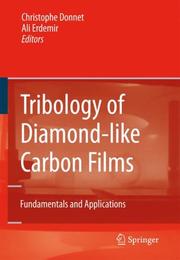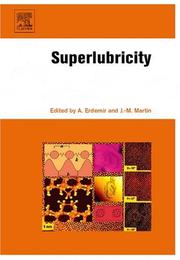| Listing 1 - 6 of 6 |
Sort by
|

ISBN: 1281139505 9786611139506 0387498915 0387302646 1441940200 9781441940209 Year: 2008 Publisher: New York : Springer,
Abstract | Keywords | Export | Availability | Bookmark
 Loading...
Loading...Choose an application
- Reference Manager
- EndNote
- RefWorks (Direct export to RefWorks)
Since their initial discovery, diamond-like carbon films have enjoyed an overwhelming interest from both the scientific and industrial communities. There now exist reliable models, computer simulations and experimental findings that clearly demonstrate their exceptional friction and wear properties. Tribology of Diamond-like Carbon Films discusses the most important structural, chemical, mechanical and tribological characteristics of DLC films, and emphasizes their applications in mechanical systems ranging in size from nano/micro (like MEMS, NEMS) to macro scale devices (like bearings, gears, aerospace mechanisms, various engine parts and components). The chapters of this book are particularly dedicated to the fundamental tribological issues that impact the performance and durability of these coatings in numerous industrial applications including automotive, microelectronic, aerospace, biomedical, and manufacturing. Written by some of the most prominent world experts representing academia, national laboratories, and industrial companies, Tribology of Diamond-like Carbon Films is an important book for researchers and engineers.
Tribology. --- Diamond thin films. --- Carbon. --- Friction --- Surfaces (Technology) --- Thin films --- Group 14 elements --- Light elements --- Chemistry, inorganic. --- Mechanics. --- Mechanics, Applied. --- Manufactures. --- Nanotechnology. --- Mechanical engineering. --- Tribology, Corrosion and Coatings. --- Solid Mechanics. --- Manufacturing, Machines, Tools, Processes. --- Atomic, Molecular, Optical and Plasma Physics. --- Mechanical Engineering. --- Inorganic chemistry --- Chemistry --- Inorganic compounds --- Engineering, Mechanical --- Engineering --- Machinery --- Steam engineering --- Molecular technology --- Nanoscale technology --- High technology --- Manufactured goods --- Manufactured products --- Products --- Products, Manufactured --- Commercial products --- Manufacturing industries --- Applied mechanics --- Engineering mathematics --- Classical mechanics --- Newtonian mechanics --- Physics --- Dynamics --- Quantum theory --- Corrosion and anti-corrosives. --- Coatings. --- Atoms. --- Physics. --- Anti-corrosive paint --- Atmospheric corrosion --- Metal corrosion --- Metals --- Rust --- Rustless coatings --- Chemical inhibitors --- Chemistry, Technical --- Fouling --- Materials --- Weathering --- Paint --- Protective coatings --- Waterproofing --- Natural philosophy --- Philosophy, Natural --- Physical sciences --- Chemistry, Physical and theoretical --- Matter --- Stereochemistry --- Surface coatings --- Coating processes --- Corrosion --- Deterioration --- Surfaces --- Constitution
Book
ISBN: 9783319147710 3319147706 9783319147703 3319147714 Year: 2015 Publisher: Cham : Springer International Publishing : Imprint: Springer,
Abstract | Keywords | Export | Availability | Bookmark
 Loading...
Loading...Choose an application
- Reference Manager
- EndNote
- RefWorks (Direct export to RefWorks)
This book describes current, competitive coating technologies for vehicles. The authors detail how these technologies impact energy efficiency in engines and with increased use of lightweight materials and by varying coatings applications can resolve wear problems, resulting in the increased lifecycle of dies and other vehicle components.
Materials Science. --- Tribology, Corrosion and Coatings. --- Automotive Engineering. --- Transportation. --- Energy Efficiency (incl. Buildings). --- Engineering. --- Chemistry, inorganic. --- Ingénierie --- Materials. --- Chemical & Materials Engineering --- Mechanical Engineering --- Engineering & Applied Sciences --- Materials Science --- Mechanical Engineering - General --- Motor vehicles --- Coating processes. --- Surface coating processes --- Automotive vehicles --- Materials science. --- Energy efficiency. --- Automotive engineering. --- Tribology. --- Corrosion and anti-corrosives. --- Coatings. --- Coatings --- Surfaces (Technology) --- Transportation, Automotive --- Vehicles --- Energy Efficiency. --- Construction --- Industrial arts --- Technology --- Inorganic chemistry --- Chemistry --- Inorganic compounds --- Consumption of energy --- Energy efficiency --- Fuel consumption --- Fuel efficiency --- Power resources --- Energy conservation --- Public transportation --- Transport --- Transportation --- Transportation, Primitive --- Transportation companies --- Transportation industry --- Locomotion --- Commerce --- Communication and traffic --- Storage and moving trade --- Surface coatings --- Materials --- Coating processes --- Thin films --- Anti-corrosive paint --- Atmospheric corrosion --- Metal corrosion --- Metals --- Rust --- Rustless coatings --- Chemical inhibitors --- Chemistry, Technical --- Fouling --- Weathering --- Paint --- Protective coatings --- Waterproofing --- Friction --- Economic aspects --- Corrosion --- Deterioration --- Surfaces

ISBN: 9780444527721 0444527729 9780080525303 008052530X 9786611023584 1281023582 Year: 2007 Publisher: Amsterdam London Elsevier
Abstract | Keywords | Export | Availability | Bookmark
 Loading...
Loading...Choose an application
- Reference Manager
- EndNote
- RefWorks (Direct export to RefWorks)
Superlubricity is defined as a sliding regime in which friction or resistance to sliding vanishes. It has been shown that energy can be conserved by further reducing/removing friction in moving mechanical systems and this book includes contributions from world-renowned scientists who address some of the most fundamental research issues in overcoming friction. Superlubricity reviews the latest methods and materials in this area of research that are aimed at removing friction in nano-to-micro scale machines and large scale engineering components. Insight is also given into the atomic-scal
Lubrication and lubricants. --- Tribology. --- Friction --- Surfaces (Technology) --- Grease --- Lubricants --- Tribology --- Bearings (Machinery) --- Lubrication systems --- Oils and fats

ISBN: 9780444527721 0444527729 9780080525303 008052530X Year: 2007 Publisher: London Elsevier
Abstract | Keywords | Export | Availability | Bookmark
 Loading...
Loading...Choose an application
- Reference Manager
- EndNote
- RefWorks (Direct export to RefWorks)
Superlubricity is defined as a sliding regime in which friction or resistance to sliding vanishes. It has been shown that energy can be conserved by further reducing/removing friction in moving mechanical systems and this book includes contributions from world-renowned scientists who address some of the most fundamental research issues in overcoming friction. Superlubricity reviews the latest methods and materials in this area of research that are aimed at removing friction in nano-to-micro scale machines and large scale engineering components. Insight is also given into the atomic-scale origins of friction in general and superlubricity while other chapters focus on experimental and practical aspects or impacts of superlubricity that will be very useful for broader industrial community. * Reviews the latest fundamental research in superlubricity today * Presents 'state-of-the-art' methods, materials, and experimental techniques * Latest developments in tribomaterials, coatings, and lubricants providing superlubricity.
Book
ISBN: 0444643133 0444643141 9780444643148 9780444643131 Year: 2021 Publisher: Amsterdam, Netherlands Elsevier
Abstract | Keywords | Export | Availability | Bookmark
 Loading...
Loading...Choose an application
- Reference Manager
- EndNote
- RefWorks (Direct export to RefWorks)
Lubrication and lubricants. --- Grease --- Lubricants --- Tribology --- Bearings (Machinery) --- Lubrication systems --- Oils and fats
Multi
ISBN: 9780444643148 0444643141 0444643133 9780444643131 Year: 2021 Publisher: Amsterdam, Netherlands Elsevier
Abstract | Keywords | Export | Availability | Bookmark
 Loading...
Loading...Choose an application
- Reference Manager
- EndNote
- RefWorks (Direct export to RefWorks)
| Listing 1 - 6 of 6 |
Sort by
|

 Search
Search Feedback
Feedback About UniCat
About UniCat  Help
Help News
News